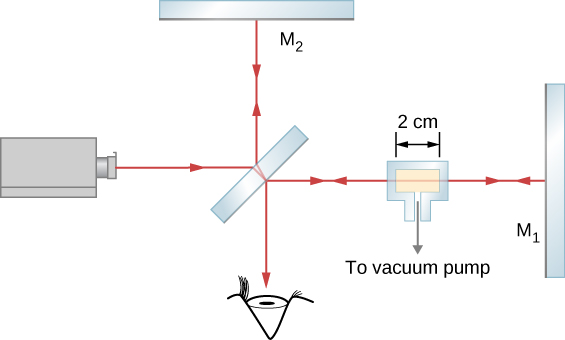| << Chapter < Page | Chapter >> Page > |

where is the wavelength in vacuum of the light used. In any other medium, the wavelength is and the number of wavelengths that fit in the gas-filled chamber is
The number of fringes observed in the transition is
Solving for gives
and .
Check Your Understanding Although m , the number of fringes observed, is an integer, which is often regarded as having zero uncertainty, in practical terms, it is all too easy to lose track when counting fringes. In [link] , if you estimate that you might have missed as many as five fringes when you reported fringes, (a) is the value for the index of refraction worked out in [link] too large or too small? (b) By how much?
a. too small; b. up to
Step 1. Examine the situation to determine that interference is involved . Identify whether slits, thin films, or interferometers are considered in the problem.
Step 2. If slits are involved , note that diffraction gratings and double slits produce very similar interference patterns, but that gratings have narrower (sharper) maxima. Single-slit patterns are characterized by a large central maximum and smaller maxima to the sides.
Step 3. If thin-film interference or an interferometer is involved, take note of the path length difference between the two rays that interfere . Be certain to use the wavelength in the medium involved, since it differs from the wavelength in vacuum. Note also that there is an additional phase shift when light reflects from a medium with a greater index of refraction.
Step 4. Identify exactly what needs to be determined in the problem (identify the unknowns) . A written list is useful. Draw a diagram of the situation. Labeling the diagram is useful.
Step 5. Make a list of what is given or can be inferred from the problem as stated (identify the knowns) .
Step 6. Solve the appropriate equation for the quantity to be determined (the unknown) and enter the knowns . Slits, gratings, and the Rayleigh limit involve equations.
Step 7. For thin-film interference, you have constructive interference for a total shift that is an integral number of wavelengths. You have destructive interference for a total shift of a half-integral number of wavelengths . Always keep in mind that crest to crest is constructive whereas crest to trough is destructive.
Step 8. Check to see if the answer is reasonable: Does it make sense? Angles in interference patterns cannot be greater than , for example.

Notification Switch
Would you like to follow the 'University physics volume 3' conversation and receive update notifications?